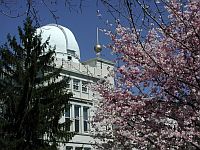
Time ball at US Naval Observatory, Washington D.C.
Last night in New York City, up to one million people watched a jeweled ball drop in Time Square at exactly midnight to mark the arrival of the New Year. Over a billion people are believed to have watched the festivities on television or on-line. The six ton Waterford crystal ball covered in 32,276 LED lights is not actually “dropped” but lowered from a flag pole on the roof of One Times Square. In New York City, the tradition dates back to 1908. But where did the tradition of dropping a ball to mark the time originate? The practice dates back to 1829 and was related to helping sailors calculate their position at sea.
When out of sight of land, a navigator can determine latitude, his position north or south on the globe, by measuring the altitude of the sun using only a sextant and a nautical almanac. To determine longitude, his position east or west, however, a navigator must compare the time of the locally observed noon with the time on his chronometer, usually set to the time in Greenwich. UK. The first chronometers rugged enough for use at sea were developed by John Harrison and others in the mid to late 18th century. By the 19th century, marine chronometers were adopted on naval ships and many merchant vessels.
But how could a navigator easily and precisely set his ship’s chronometers? To solve this problem, the Royal Navy’s Captain Robert Wauchope invented the time ball in 1829. It was large ball hoisted to the top of a pole on a building easily visible to ships in the harbor. The ball would be lowered at a precise time, usually noon or 1PM. When the navigators on ships in the local harbor saw the ball beginning to drop they could use it to set their chronometers to the exact time.
The first time ball was erected in Portsmouth in 1829, followed by a time ball at the Greenwich Observatory in 1833 and at the US Naval Observatory in Washington in 1845. Soon, time balls were installed in ports around the world.
With the advent of radio time signals in the 1920s, the time balls became obsolete. Nevertheless the time balls at the Greenwich Observatory and the US Naval Observatory continue to drop every day to give both locals and ships on the rivers a means of setting their watches. And, when the ball drops at midnight every year at Time Square, watched by countless millions, the bejeweled ball pays homage to Robert Wauchope’s invention, the time ball.
Happy New Year to all.

Interesting, but bejeweled?
Anyway, while reading earlier, I read the 6 tons and I thought, what damage it would do if it came off the pole, no idea why I thought that?
As for watching it, I was switching channels and must have found a sleeping movie and was back up at 5:30am, no big deal now that I’m older, wouldn’t want to be in that crowd anyway, no way out in an emergency, no one things of that.
neat, had no idea! thanks for posting this!
The Edinburgh ball was raised slowly to give warning of the impending drop.
Time was sold by street vendors with watches that had been synchronised with the time ball for one old penny a time.
The Edinburgh Castle’s famous “one o’clock gun” whose purpose was to supply a time signal irrespective of visibility was timed by and for a while connected electronically to the time keeping mechanism. To take account of the speed of sound, maps were published with the time delay.
( http://www.edinphoto.org.uk/1_edin/1_edinburgh_history_-_time-gun.htm )
“Still closer, the Nelson Monument offers the best view of the various structures on the top of Calton Hill itself. The largest is the 1818 City Observatory, with the 1776 Observatory House at one corner and the Playfair Monument at another. The observatory was intended principally to take accurate measurements of time. These were first conveyed to the citizens of Edinburgh and the mariners of Leith by what was known as a “politician’s” clock (one with two faces).
Later the Observatory was connected to a time signal erected on the top of the Nelson Monument itself. The large white time-ball drops precisely at 12 noon Greenwich Mean Time on week-days. This equates to 1pm during British Summer Time, so for half the year its dropping coincides with the firing of the one o’clock gun from Edinburgh Castle. Indeed for many years the Observatory was connected by a 4000ft electric wire stretched high across the city to the Castle to ensure the one o’clock gun kept precisely to time. Nearby is the Dugald Stewart Monument, built in 1831 by the architect William Henry Playfair.” (extract from : http://www.undiscoveredscotland.co.uk/edinburgh/caltonhill/ )
There was one in the South Street Seaport in New York City, a black ball raised and lowered, nearby and symbolically on the RMS Titanic Memorial. (http://tinyurl.com/hxtds95) There was also a “Black Ball” line started in 1817 by Quaker businessmen who ran two week packets of mail and passengers to Liverpool, England and back. They had a distinctive black ball painted on their mainsails.
it’s interesting how this new year’s eve tradition gets played out in other places. in northern georgia i know of a “possum drop.” supposedly no possums are injured. in florida, there’s a shrimp basket drop; there the shrimps don’t survive because they get eaten.
Apparently, Key West has a drag queen drop and a pirate wench drop, within a few blocks of each other. . So far I haven’t had the pleasure to witness either.
Drag Queen Drop Highlights Key West New Year’s Eve